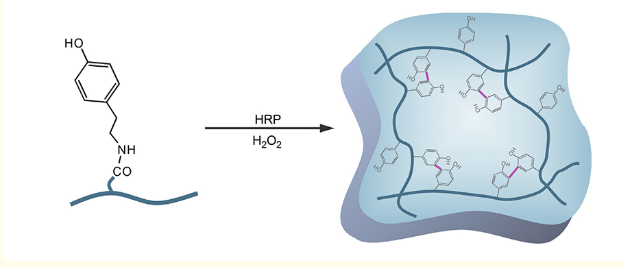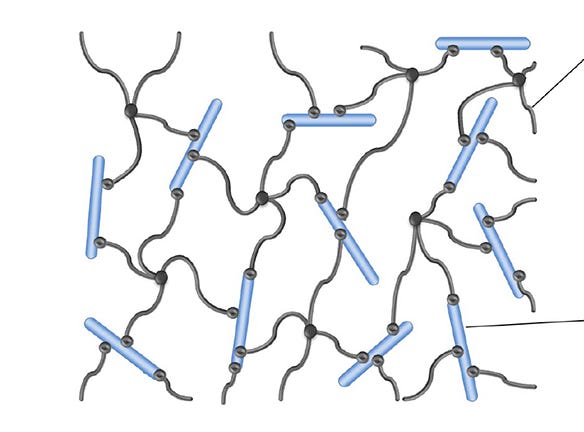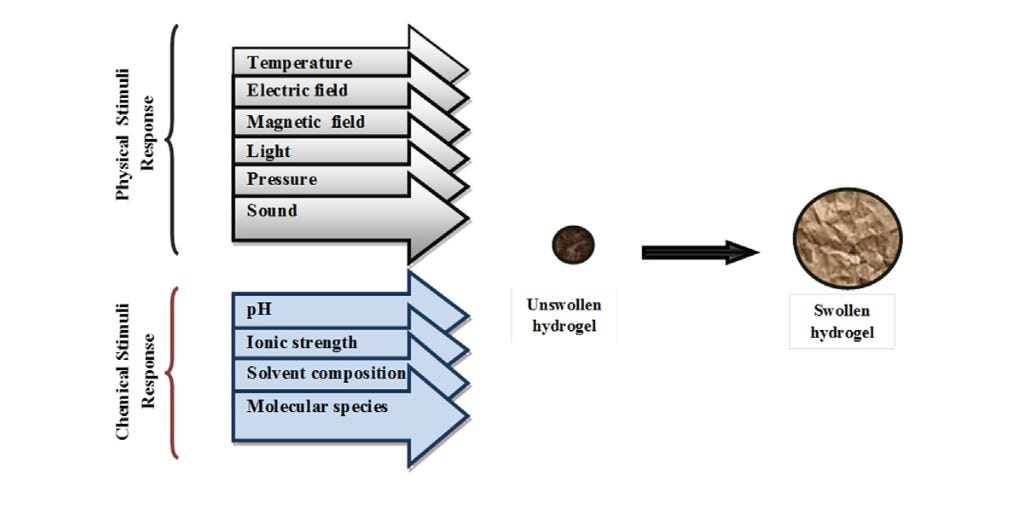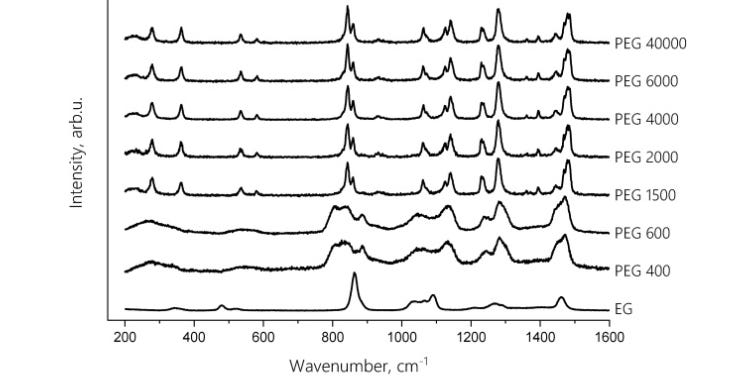With graphene oxide (GO) presumptively discussed as a contaminant, we show here that reduced graphene oxide has been developed as a hydrogel.
Following on Dr. Pablo Campra’s first vaccine vial report, I’d like to point out that the Raman spectra data and observations suggested that reduced graphene oxide was suspended in a hydrogel.
This is not the same as saying there’s some graphene or GO contaminating the preparation. It’s saying there appears to be a graphene hydrogel suspension in the vial.
To more fully define hydrogel:
“A hydrogel is a three-dimensional (3D) network of hydrophilic polymers that can swell in water and hold a large amount of water while maintaining the structure due to chemical [covalent/ionic] or physical [bonds between molecules that are close to each other, such as hydrogen-hydrogen bonds, for example] cross-linking of individual polymer chains. Hydrogels were first reported by Wichterle and Lím (1960). By definition, water must constitute at least 10% of the total weight (or volume) for a material to be a hydrogel.”
Here is a basic depiction of a hydrogel (right portion only as Substack won’t let me crop this image):

Here is a depiction of what is meant by cross-linking of the polymers:

Polymers composing hydrogels are often “polyelectrolytes”, which are polymers bearing an electrolyte group(s). The electrolytes dissociate (ionize) in water, making the polymers charged.
Hence, hydrogels can be anionic, cationic or neutral. They can contain one or more types of polymers that can be either fully cross-linked or semi-cross-linked.
Hydrogel structures are thus either crystalline, semi-crystalline, amorphous or hydrocolloid (particle suspension in water), but in any event they are elastic structures as suggested by their name “gel”. They are also porous.
Hydrogels thus also react to physical and chemical or biochemical stimuli.
Polyelectrolyte hydrogels are pH-sensitive; others are sensitive to temperature changes. Other hydrogels may be sensitive to electric and magnetic fields, light, pressure, or other chemical changes.
Enzymes and amino acids are sometimes used to create biochemical hydrogels, based on the intent of the gel. For example, fibrin peptides are used as a cross-linker in some hydrogels said to be biodegradable, as natural fibrinogen would break them down in the body.
Here is a schematic showing the factors used or involved in producing a hydrogel from solution:

Depiction of hydrogel creation
Since medical science tends to follow its funding, it is no mistake that the most researched and talked-about applications of hydrogels are pharmaceutical, specifically pharmaceutical drug delivery, although blood coagulation and tissue scaffolding are also considered applications, among others.
The later literature cited above shows that acrylic or polyacryilamide, polyvinyl alcohol (PVA) and polyethylene glycol (PEG) (a petroleum-based compound) are most commonly used or planned to be used for drug delivery.
This would theoretically allow toxic drugs to be targeted and avoid damaging non-target tissue, among other applications.
Of course, these compounds themselves are themselves toxic. Natural polymers such as collagen/gelatin, chitosan and hyaluron can be used, but are not as used in hydrogel medical application due to cost and lesser customizability. They are being considered for tissue engineering application, however.
Addressing a question I received from a reader, if PEG has been found in vaccinated women’s breast milk and found to be from the vaccination — which is not confirmed in any way — it is possible that PEG is in these preparations.
The Raman spectra of PEG in the 1200-1600 wave region are close to the 1450 cm-1 found by Dr. Campra — but so are the spectra of acrylamides and other synthetic polymers, as he also suggested.
So, no determination can be made about hydrogel composition until we have more data on it.

Raman spectra of PEG of different weights, and ethylene glycol (EG) in the 1200–1600 wave region. A peak around 1450 cm -1 is associated with EG and lower-weight PEG as well as other known hydrogel constituents.
Scientists have been making PEG hydrogels since 1993, and of course those are claimed to be nontoxic. However, as the above study also attests, little effort has been made to do high-quality toxicology research on PEG.
For example, one 2017 study tested PEG for cellular toxicity on the infamous HeLa cells, which are a cervical cancer cell line, and a cell line of fibroblasts derived from mice (L929).
“Cell lines” are not natural cells but clones of mutated or cancerous cells that are able to grow for long periods in culture. As cell lines are defective and unnatural cells, they usually exhibit some deficiency or excess in function that makes them amenable to eliciting the result.
HeLa cells, for example, have an overactive form of telomerase, the enzyme that makes telomeres, which are repeated genetic sequences at the ends of chromosomes that prevent them from shortening to their death, as is normal.
HeLa cells grow so aggressively that their use in culture is being re-examined.
The infamous Vero cells (monkey kidney Vero E6), a cell line which is used almost exclusively in viral “isolation” experiments, lacks interferon and is thus “immunodeficient”. This means these cells break down easily.
Thus it is very easy to show the “proof” of “viruses” by using Vero cells, which are in reality exosome release from the breaking-down cells.
Vero cells were used by John Enders in the first modern viral “isolation” experiment (measles), by Jonas Salk to “test” his polio vaccine, and are claimed to be used by Judy Mikovits to grow her alleged viruses. Vero cells appear to be about the only thing “viruses” can be “grown on”.
Meanwhile, other cell lines have different characteristics that make them amenable to cell culture-based research, and are usually chosen based on the characteristic the researcher needs to effect their lab results.
(And, it is further known that up to a third of cell lines are commonly mislabeled.)
Recent studies on PEG, however, have undermined the common, prevailing assumption in the medical industry that PEG is nontoxic. One study based on FDA adverse event data showed that children given PEG as a laxative medication suffered neuropsychiatric adverse effects.
(Nice to know that children were given PEG as a standalone medication before any real toxicology was done!)
Further animal studies showed that animals had to be euthanized after injection of PEG. Another animal study euthanized dogs 24 hours after they showed symptoms of PEG toxicity and declared no toxicity.
PEG has also been found to be “immunogenic” (elicits “IgM antibodies”). However, the specificity and interpretation of antibody tests is suspect, as noted.
Nevertheless, “PEGylation” (attaching PEG to proteins, lipids, etc.) is said to be one of the “most attractive” biotechnologies achieving “huge success” in the industry.
So here is a 2013 paper describing a prototype of a reduced graphene oxide (rGO) hydrogel that is a hybrid hydrogel containing metallic nanoparticles.
Metallic particles have been found in the vial samples by many researchers, and metal ions or metallic nanoparticles are commonly used in hydrogels to increase their mechanical strength. Some samples analyzed so far have shown little or no metals however, to be clear.
This paper describes a particular method of using polyamines (amino-containing polymers, such as hypothesized to be in the hydrogel by Campra and Andersen) to simultaneously reduce metal ions and graphene oxide to create a hybrid graphene oxide-metal nanoparticle hydrogel.
I believe this is a prototype concept of what may be in the jab, but the exact composition is unknown and/or variable and I am not claiming any specific method of preparation.
What is in the jab may not be 99% water, as this hydrogel is said to be; it may well be substantially less. However, it must be at least 10% water. It also may not contain the amount of metal in the prototype study, or any metal, and it does not contain the precious metals as used in the prototype.
This is just a prototype of a reduced graphene oxide-based hydrogel technology for all to understand based on the literature, and based on the Raman spectra derived from Campra. The prototype shown in this 2013 paper indicates a possible use as a reducing agent.
There are in fact hundreds of papers in PubMed regarding the use of graphene oxide in hydrogels for a variety of proposed purposes.
Engineered hydrogels form the basis of many interventionist biotechnologies planned to become part of the Rockefeller medical system, applied from blood coagulation to tissue engineering.
It has even been suggested in the medical scientific literature that hydrogels are being considered to replace cell cultures.
And, scientists have also created GO-based “aerogels” which are made from GO-based hydrogels, for other applications.
Further study of hydrogels and hydrogel-based technologies is certainly suggested.
Dr. Campra in fact has a new study of DNA crystals that will help us further elaborate the GO hydrogel-based technology in future posts.
For the next installment of “What’s in the jab and what’s not”, however, I will return to the RNA issue in light of ongoing misinformation in the alt media, and in light of a new JAMA study claiming vaccine RNA has been found in breast milk post-vaccine.
More serious study needs to be made of the vials’ contents, as regards presumed hydrogel (medium) composition as well as further verification that RNA and lipids are not in the jab.
However, we learned last month that Pfizer and Moderna have been refusing requests from labs to study the vial contents, citing their legal dispute as an excuse to withhold the vials.
I hope labs persist nonetheless and show the courage to publish their results on the Internet for all to see.
Courtsey: https://pseudoscience.substack.com/p/a-reduced-graphene-oxide-hydrogel
